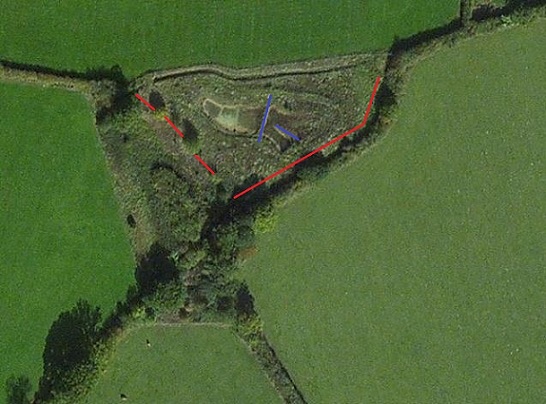This summer has been a bit of a nightmare for getting out to our more open sites: with three visits to Brown's Farm and two to Blakehill being scuppered by the weather. It seems that we have managed to get hit by rain or high winds whenever such a visit is scheduled. Today we were scheduled for a session at Ravensroost Meadows, specifically the meadow pond and its surroundings. It is an excellent place at this time of year, as you never know what will drop in. The nets were set around the edge of the pond area. The red lines are the hedgerow nets, the blue lines are the nets over the causeway and along the spit on the eastern end of the pond.
Fortunately, the weather forecast was completely accurate, with a completely dry day and the wind speed never getting above 2mph. I had a team of Jonny, David, Steph and Lillie with me. At the equivalent session last year Jonny and I had a good catch of 92 birds, and we were hoping for something similar this time. The first round delivered a respectable 30 birds, including four Swallows caught in the causeway net. This was followed by a second round of 37 birds. It then settled down to a pretty regular 10 birds or so per round, which gave everybody a chance to ring some new species, and have the time to discover about ageing them at this difficult time of year.
Difficult because in many species, like Chiffchaff, adult and juvenile plumage is very similar. Immediately post-fledging, the youngsters have very fresh plumage, they then undergo their post-fledging moult, replacing poor quality body feathers adequate in the nest with better quality feathers for life on the wing. Whilst this is going on, their wing and tail feathers wear from foraging and their daily activities. At the same time, many of the adults have completed their post-breeding moult and now have fresh wing and tail feathers, like the youngsters but with slightly less wear. To compound the issue, we are still catching newly-fledged youngsters in full juvenile plumage, and some that are only part way through their post-fledging moult.
The highlight was our first Sedge Warbler at the complex. We have caught Reed Warblers there on occasion, but this was a good first. There is a larger pond at the complex which, once upon a time, supported both Sedge and Reed Warblers. Unfortunately, it is now horribly overgrown and full of Typha and is not suitable habitat for breeding warblers. It will need a lot of work to clear it out and make it suitable again. Any volunteers for a work party? Waders essential.
The list for the day was: Great Spotted Woodpecker 1; Swallow 25; House Martin 3; Blue Tit 21(1); Great Tit 4; Marsh Tit (1); Wren 6; Dunnock 2(1); Meadow Pipit 2; Robin 4; Sedge Warbler 1; Blackcap 7; Garden Warbler 1; Whitethroat 4; Lesser Whitethroat 4; Chiffchaff 21(1); Willow Warbler 8; Chaffinch 1; Goldfinch 18; Bullfinch 2; Reed Bunting. Totals: 136 birds ringed from 20 species, four birds retrapped from four species, making 140 birds processed from 21 species. All of the birds were juveniles except for one adult each of Swallow, Great Tit, Robin, Blackcap, Lesser Whitethroat, Willow Warbler, Bullfinch and the Great Spotted Woodpecker.
In addition to the Sedge Warbler, we caught our third and fourth Meadow Pipits at the site. Previously we have caught singletons in September 2014 and 2015. The retrapped Marsh Tit was ringed inside the wood at the end of July this year. It is a juvenile, possibly on dispersal looking for a territory away from the natal area. ST/JC/DW/SB/LW

